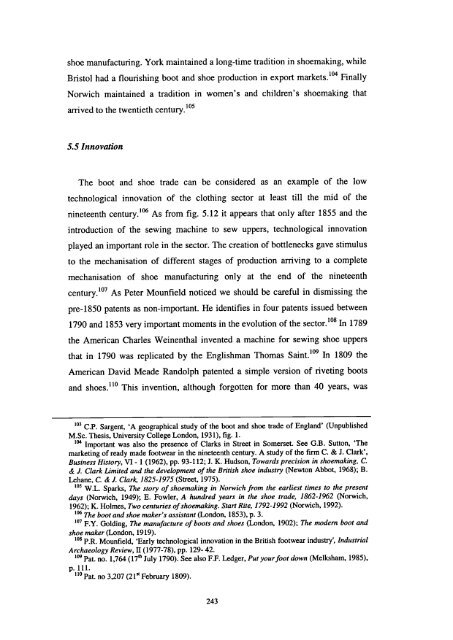The Boot and Shoe Trades in London and Paris in the Long Eighteenth Century
The Boot and Shoe Trades in London and Paris in the Long Eighteenth Century
The Boot and Shoe Trades in London and Paris in the Long Eighteenth Century
You also want an ePaper? Increase the reach of your titles
YUMPU automatically turns print PDFs into web optimized ePapers that Google loves.
shoe manufactur<strong>in</strong>g. York ma<strong>in</strong>ta<strong>in</strong>ed a long-time tradition <strong>in</strong> shoemak<strong>in</strong>g, while<br />
Bristol had a flourish<strong>in</strong>g boot <strong>and</strong> shoe production <strong>in</strong> export markets.'°4 F<strong>in</strong>ally<br />
Norwich ma<strong>in</strong>ta<strong>in</strong>ed a tradition <strong>in</strong> women's <strong>and</strong> children's shoemak<strong>in</strong>g that<br />
arrived to <strong>the</strong> twentieth century.'°5<br />
5.5 Innovation<br />
<strong>The</strong> boot <strong>and</strong> shoe trade can be considered as an example of <strong>the</strong> low<br />
technological <strong>in</strong>novation of <strong>the</strong> cloth<strong>in</strong>g sector at least till <strong>the</strong> mid of <strong>the</strong><br />
n<strong>in</strong>eteenth century.'°6 As from fig. 5.12 it appears that only after 1855 <strong>and</strong> <strong>the</strong><br />
<strong>in</strong>troduction of <strong>the</strong> sew<strong>in</strong>g mach<strong>in</strong>e to sew uppers, technological <strong>in</strong>novation<br />
played an important role <strong>in</strong> <strong>the</strong> sector. <strong>The</strong> creation of bottlenecks gave stimulus<br />
to <strong>the</strong> mechanisation of different stages of production arriv<strong>in</strong>g to a complete<br />
mechanisation of shoe manufactur<strong>in</strong>g only at <strong>the</strong> end of <strong>the</strong> n<strong>in</strong>eteenth<br />
century.'°7 As Peter Mounfield noticed we should be careful <strong>in</strong> dismiss<strong>in</strong>g <strong>the</strong><br />
pre-1850 patents as non-important. He identifies <strong>in</strong> four patents issued between<br />
1790 <strong>and</strong> 1853 very important moments <strong>in</strong> <strong>the</strong> evolution of <strong>the</strong> sector. 108 In 1789<br />
<strong>the</strong> American Charles We<strong>in</strong>enthal <strong>in</strong>vented a mach<strong>in</strong>e for sew<strong>in</strong>g shoe uppers<br />
that <strong>in</strong> 1790 was replicated by <strong>the</strong> Englishman Thomas Sa<strong>in</strong>t.' 09 In 1809 <strong>the</strong><br />
American David Meade R<strong>and</strong>olph patented a simple version of rivet<strong>in</strong>g boots<br />
<strong>and</strong> shoes.' 1° This <strong>in</strong>vention, although forgotten for more than 40 years, was<br />
103 C.P. Sargent, 'A geographical study of <strong>the</strong> boot <strong>and</strong> shoe trade of Engl<strong>and</strong>' (Unpublished<br />
M.Sc. <strong>The</strong>sis, University College <strong>London</strong>, 1931), fig. 1.<br />
104 Important was also <strong>the</strong> presence of Clarks <strong>in</strong> Street <strong>in</strong> Somerset. See G.B. Sutton, '<strong>The</strong><br />
market<strong>in</strong>g of ready made footwear <strong>in</strong> <strong>the</strong> n<strong>in</strong>eteenth century. A study of <strong>the</strong> firm C. & J. Clark',<br />
Bus<strong>in</strong>ess History, VI - 1 (1962), pp. 93-112; J. K. Hudson, Towards precision <strong>in</strong> shoemak<strong>in</strong>g, C.<br />
& J. Clark Limited <strong>and</strong> <strong>the</strong> development of <strong>the</strong> British shoe <strong>in</strong>dustry (Newton Abbot, 1968); B.<br />
Lehane, C. & J. Clark 1 825-1975 (Street, 1975).<br />
105 W.L. Sparks, <strong>The</strong> story of shoemak<strong>in</strong>g <strong>in</strong> Norwich from <strong>the</strong> earliest times to <strong>the</strong> present<br />
days (Norwich, 1949); E. Fowler, A hundred years <strong>in</strong> <strong>the</strong> shoe trade, 1862-1962 (Norwich,<br />
1962); K. Holmes, Two centuries of shoemak<strong>in</strong>g. Start Rite, 1 792-1992 (Norwich, 1992).<br />
106 <strong>The</strong> boot <strong>and</strong> shoe maker's assistant (<strong>London</strong>, 1853), p. 3.<br />
'° F.Y. Gold<strong>in</strong>g, <strong>The</strong> manufacture of boots <strong>and</strong> shoes (<strong>London</strong>, 1902); <strong>The</strong> modern boot <strong>and</strong><br />
shoe maker (<strong>London</strong>, 1919).<br />
108 P.R. Mounfield, 'Early technological <strong>in</strong>novation <strong>in</strong> <strong>the</strong> British footwear <strong>in</strong>dustry', <strong>in</strong>dustrial<br />
Archaeology Review, II (1977-78), pp. 129- 42.<br />
'°9 Pat. no. 1,764 (17th July 1790). See also F.F. Ledger, Put your foot down (Melksham, 1985),<br />
p.111.<br />
"°Pat. no 3,207 (215t February 1809).<br />
243


